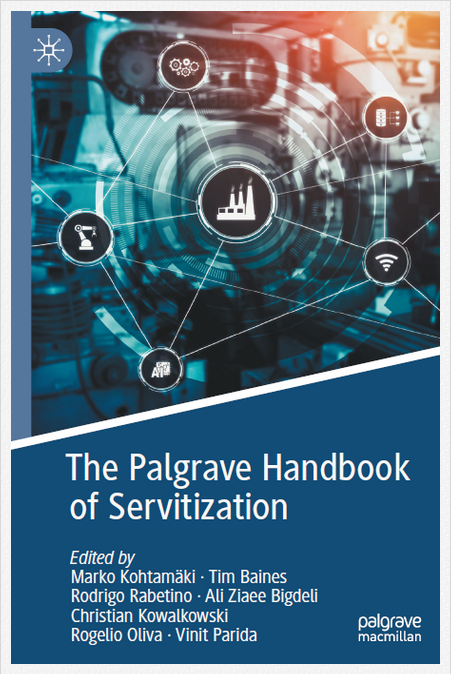The Palgrave Handbook of Servitization
Coactis a contribué au Palgrave Handbook of Servitization au travers de deux chapitres (résumés ci-après), l’un par Sophie Peillon, enseignant chercheur aux Mines St-Etienne et l’autre par Tinhinane Tazaïrt, doctorante et Isabelle Prim-Allaz, enseignant-chercheur à Lyon 2.
Sophie Peillon, Organizational structures in servitization : Should product and service business be separated or integrated?
Tinhinane Tazairt et Isabelle Prim-Allaz., Configurational servitization approach: A necessary alignment of service strategies, digital capabilities and customer resources (avec le soutien financier de la région AURA dans le cadre du projet AURA-PMI).
in Kohtamäki M., Baines T., Rabetino R., Ziaee Bigdeli A., Kowalkowski C., Oliva R. & Parida V. (2021), The Palgrave Handbook of Servitization : Theories and concepts in servitization and product-service systems, Palgravre McMillan (September), https://www.palgrave.com/gp/book/9783030757700
__________________________________________________________________________________________________________________________
Résumés des chapitres:
Sophie Peillon, Organizational structures in servitization : Should product and service business be separated or integrated?
Organizational structure appears as one of the major challenges in the servitization of manufacturing firms (Zhang and Banerji 2017). Decisions about organizational structure are closely linked to those about strategy, and manufacturers need to decide whether to integrate or separate product and service business units (Raddats et al. 2019). However, there is no consensus and the literature on servitization still does not provide a clear answer on the question of the separation or integration of service and product activities.
This chapter will provide an overview on the debate between integration and separation of product and service activities within manufacturing firms. It will highlight the arguments that support the separation – protecting the service culture, operating as a service company with dedicated staff, processes and systems (Gebauer et al. 2010; Oliva & Kallenberg, 2003; Oliva et al. 2012), and those pleading in favor of the integration – a better alignment with market needs, in case of services intended to protect or improve the product, or in order to offer repeatable customer solutions (Auguste et al. 2006 ; Gebauer & Kowalkowski, 2012; Neu & Brown, 2005, 2008).
As a discussion, it will question the very existence of an optimal organizational structure, and the underlying positivist epistemology and ideology of managerialism, which lead to conceive servitization as consisting “of universal laws or models that refer to change as a linear and planned process” (Luoto et al. 2017: 96).
Tinhinane Tazairt et Isabelle Prim-Allaz, Configurational servitization approach: A necessary alignment of service strategies, digital capabilities and customer resources
Implementing servitization involves a number of organisational, strategic and operational challenges in manufacturing companies. Servitization is not always successful and failures often result from a misunderstanding of the concept itself and of its conditions of implementation, its heterogeneity being a true challenge for firms.
This chapter re-examines the current understanding of servitization and proposes different servitization approaches showing that the focus of servitization can be placed on either the offer, processes, uses, results, degrees or methods of innovation. These approaches are not necessarily exclusive from each other and correspond to different servitized value propositions. Regardless of the definition or the approach of servitization under consideration here, there is a consensus to adopt a customer-centric approach to servitization. Servitization is also closely linked to digitalization, which is itself considered as both a driver and an enabler of servitization.
Scholars point out a service paradox, potentially reinforced by a digital one. When implementing a service strategy articulated with digitalization, companies may face a digital service paradox (DSP) as a result of the interplay of these elements.
In this chapter, the authors explain how to operate a configurational approach to servitization, which aligns service strategies with digitalization capabilities and customer resources. This allows us to point to new approaches to successfully implementing servitization.
The main theoretical contribution to the field is an innovative reading of servitization which takes into account the heterogeneity of its approaches, objectives and related servitized value propositions. Considering this multiplicity of situations and paths to success allows to consider more than one way to overcome the digital service paradox. From a managerial perspective, the authors help manufacturing companies to implement servitization by proposing an integrative framework based on the configurational approach of servitization: we put forward different combinations of service strategies, digital capabilities and customer resources.

